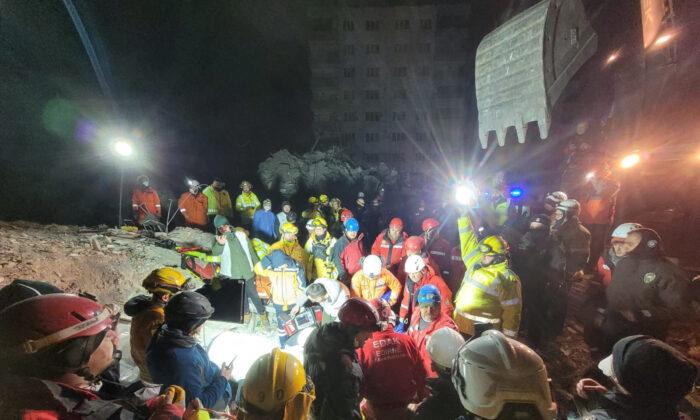ANTAKYA, Turkey/JANDARIS, Syria—Rescuers in Turkey pulled more people from the rubble early on Saturday, five days after the country’s most devastating earthquake since 1939, but hopes were fading in Turkey and Syria that many more survivors would be found.
In Kahramanmaras, close to the quake’s epicenter in southern Turkey, there were fewer visible rescue operations amid the smashed concrete mounds of fallen houses and apartment blocks, while ever more trucks rumbled through the streets shipping out debris.
The death toll kept growing—exceeding 25,250 across southern Turkey and northwest Syria. Turkish President Tayyip Erdogan, facing questions over earthquake planning and response time, has said authorities should have reacted faster.
Erdogan promised to start work on rebuilding cities “within weeks,” saying hundreds of thousands of buildings were now uninhabitable, while issuing stern warnings against any people involved in looting in the quake zone.
In the Turkish city of Antakya, several residents and rescue workers said they had seen looting.
In the rebel enclave of northwest Syria that suffered the country’s worst damage from the earthquake but where relief efforts are complicated by the more than decade-old civil war, very little aid had entered despite a pledge from Damascus to improve access.
In Antakya, body bags lay on city streets and residents were wearing masks to try to cover the smell of death.
At one building in Kahramanmaras, rescue workers burrowed between concrete slabs to reach a five year-old girl, lifting her on a stretcher, wrapped in foil, and chanting “God is great.”
They said they believed two more survivors were clinging on under the same mound of rubble.
But though several other people were reportedly saved from the rubble on Saturday including 13 year-old Arda Can Ovan, few rescue efforts now result in success. A woman who was rescued on Friday in Kirikhan in Turkey died in hospital on Saturday.
The danger in such operations was evident in a video filmed in Hatay in Turkey, showing a partially collapsed building suddenly slipping and burying a rescuer in an avalanche of debris before his colleagues could haul him out.
About 80,000 people were being treated in hospital, while 1.05 million left homeless by the quakes were in temporary shelters, Turkish Vice President Fuat Oktay told reporters overnight.
Across the devastated region, people waited for news of missing loved ones. Soner Zamir and Sevde Nur Zamir were squatting on Saturday in front of a mangled building in Kahramanmaras where his parents and grandparents lived.
“Some people came out yesterday but now there is no hope. This building is too shattered for life,” Zamir said.

New Graves
New graves covered a hillside outside Gaziantep, some marked with flowers or small Turkish flags flapping in the breeze.A young woman squatted next to one, holding her face. By another, a woman broke down in sobs as a boy tried to comfort her. Beyond them, rows of freshly dug graves were laid out, waiting to be filled as the city prepared to bury its dead.
Among the living, survivors feared disease, with basic infrastructure smashed.
“If people don’t die here under the rubble, they'll die from injuries, if not they will die from infection. There is no toilet here. It is a big problem,” said Gizem, a rescue worker from the southeastern Province of Sanliurfa.
U.N. aid chief Martin Griffiths, who described the earthquake as “the worst event in 100 years in this region,” praised Turkey’s emergency response, saying it was his experience that people in disaster zones were always disappointed early in relief efforts.
He said in an interview with Sky News that “I am sure (the death toll) will double or more.”

Erdogan
The disaster hit as Erdogan prepares for national elections scheduled to be held by June, and at a time when his popularity was already eroding amid the soaring cost of living and a slumping Turkish currency.Even before the quake, the vote was seen as Erdogan’s toughest challenge in two decades in power. Since the disaster, he has called for solidarity and condemned what he called “negative campaigns for political interest.”
People in the quake zone and opposition politicians have accused the government of a slow and inadequate relief early on and critics have said the army, which played a main role after a 1999 earthquake, was not involved fast enough.
Erdogan has acknowledged some problems with Turkey’s initial response, notably getting aid into a region where transport links were damaged but said the situation was subsequently brought under control.
Questions are also starting to be asked about the soundness of buildings in the quake-hit zone.
State prosecutors in Kahramanmaras said they will investigate the collapse of buildings and any irregularities in their construction. Police detained a contractor who built a 12-storey upmarket apartment block that collapsed in Hatay, as he waited to board a plane in Istanbul.
Monday’s 7.8 magnitude quake, with several powerful aftershocks across Turkey and Syria, ranks as the world’s seventh-deadliest natural disaster this century, approaching the 31,000 killed by a quake in neighboring Iran in 2003.
Syria
In Syria, people waiting for news of family members stood solemnly by mounds of crushed concrete and twisted metal.
Many residents of rebel-held northwest Syria had already been displaced from other parts of the country that were taken back by pro-government forces during the ongoing civil war but are now being made homeless again.
“On the first day we slept in the streets. The second day we slept in our cars. Then we slept in other people’s homes,” said Ramadan Sleiman, 28, whose family had fled eastern Syria to the town of Jandaris, which was badly damaged in the quake.
Dozens of planeloads of aid have arrived in areas held by the Syrian government since Monday but little has reached the northwest, the worst-affected area.
In normal times, U.N. delivers aid to the region across the border with Turkey via a single checkpoint, a policy that Damascus criticizes as violating its sovereignty.





